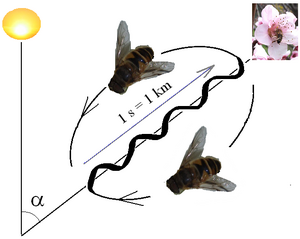Assessment |
Biopsychology |
Comparative |
Cognitive |
Developmental |
Language |
Individual differences |
Personality |
Philosophy |
Social |
Methods |
Statistics |
Clinical |
Educational |
Industrial |
Professional items |
World psychology |
Biological: Behavioural genetics · Evolutionary psychology · Neuroanatomy · Neurochemistry · Neuroendocrinology · Neuroscience · Psychoneuroimmunology · Physiological Psychology · Psychopharmacology (Index, Outline)
Waggle dance is a term used in beekeeping and ethology for a particular figure-eight dance of the honeybee. By performing this dance, successful foragers can share with their hive mates information about the direction and distance to patches of flowers yielding nectar or pollen, or both, and to water sources. Thus the waggle dance is a mechanism whereby successful foragers can recruit other bees in their colony to good locations for collecting various resources. It used to be thought that bees have two distinct recruitment dances—round dances and waggle dances—the former for indicating nearby targets and the latter for indicating distant target, but it is now known that a round dance is simply a waggle dance with a very short waggle run (see below)
A dance consists of 1-100+ circuits, each of which consists of two phases: the waggle phase and the return phase. To examine how bees communicate using waggle dances, let us follow the behavior of a bee upon her return from a rich, new food source. Excited by her discovery, she scrambles into her hive's entrance and immediately crawls onto one of hte vertical combs. Here, amidst a massed throng of her sisters, she perform her dance. This involves running through a small figure-eight pattern: a waggle run (aka waggle phase) followed by a turn to the right to circle back to the starting point (aka return phase), another waggle run, followed by a turn and circle to the left, and so on in a regular alternation between right and left turns after waggle runs. The waggle phase of the dance is the most striking and informative part of the signaling bee's performance.
The direction and duration of waggle runs are closely correlated with the direction and distance of the patch of flowers being advertised by the dancing bee. Flowers located directly in line with the sun are represented by waggle runs in an upward direction on the vertical combs, and any angle to the right or left of the sun is coded by a corresponding angle to the right or left of the upward direction. The distance between hive and recruitment target is encoded in the duration of the waggle runs,. The farther the target, the longer the waggle phase, with a rate of increase of about 75 milliseconds per 100 meters.
Amazingly, waggle dancing bees that have been in the hive for an extended time adjust the angles of their dances to accommodate the changing direction of the sun. Therefore bees that follow the waggle run of the dance are still correctly led to the food source even though its angle relative to the sun has changed.

The angle from the sun indicates direction. The duration of the waggle part of the dance signifies the distance.
The waggle dance was first deciphered scientifically by Karl von Frisch.
Dances as language
Knowledge about feeding places can be relayed from bee to bee. The means of communication is a special dance of which there are two forms:
Round dance
The “round dance” provides the information that there is a feeding place in the vicinity of the beehive at a distance between 50 and 100 meters, without the particular direction being given. By means of close contact among the bees it also supplies information about the type of food (blossom scent).
The foraging bee...begins to perform a kind of “round dance”. On the part of the comb where she is sitting she starts whirling around in a narrow circle, constantly changing her direction, turning now right, now left, dancing clockwise and anti-clockwise, in quick succession, describing between one and two circles in each direction. This dance is performed among the thickest bustle of the hive. What makes it so particularly striking and attractive is the way it infects the surrounding bees; those sitting next to the dancer start tripping after her, always trying to keep their outstretched feelers on close contact with the tip of her abdomen....They take part in each of her manoeuvrings so that the dancer herself, in her mad wheeling movements, appears to carry behind her a perpetual comet’s tail of bees.[1]
"Dialects"
The linguistic findings described above were based on Karl von Frisch’s work primarily with the Carnica variety of bees. Investigations with other varieties led to the discovery that language elements were variety-specific, so that how distance and direction information is relayed varies greatly.
References
- Gould, J. L. (1975) Honey bee recruitment: the dance-language controversy. Science 189, 685−693.
- Riley, J.R., Greggers, U., Smith, A.D., Reynolds, D.R. & Menzel, R. (2005). The flight paths of honeybees recruited by the waggle dance. Nature 435,205-207.
- Seeley, T.D. (1995) The Wisdom of the Hive. Cambridge, MA: Harvard University Press.
- von Frisch, K. (1967) The Dance Language and Orientation of Bees. Cambridge, MA: Harvard University Press.
See also
Sources
- Communication and Recruitment to Food Sources by Apis mellifera USDA-ARS, accessed March 2005
- Honeybee Communication Kimball's Biology Pages, accessed September 2005
de:Tanzsprache es:Danza de la abeja lt:Bičių šokiai zh:蜜蜂舞蹈
This page uses Creative Commons Licensed content from Wikipedia (view authors).
- ↑ von Frisch, op.cit., p. 102ff.